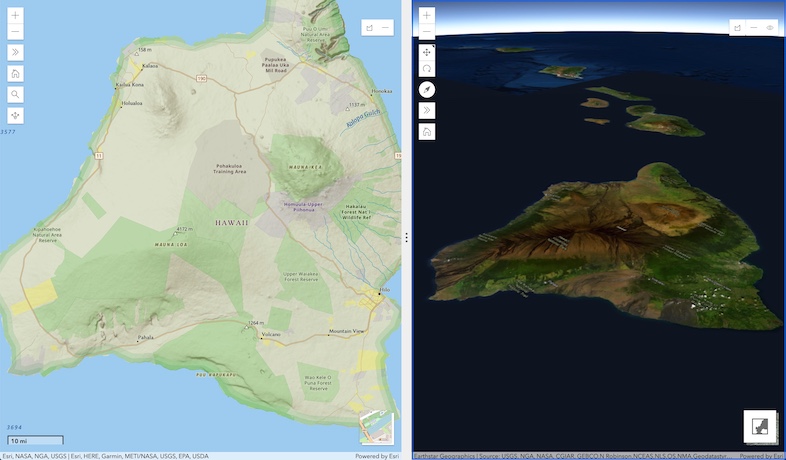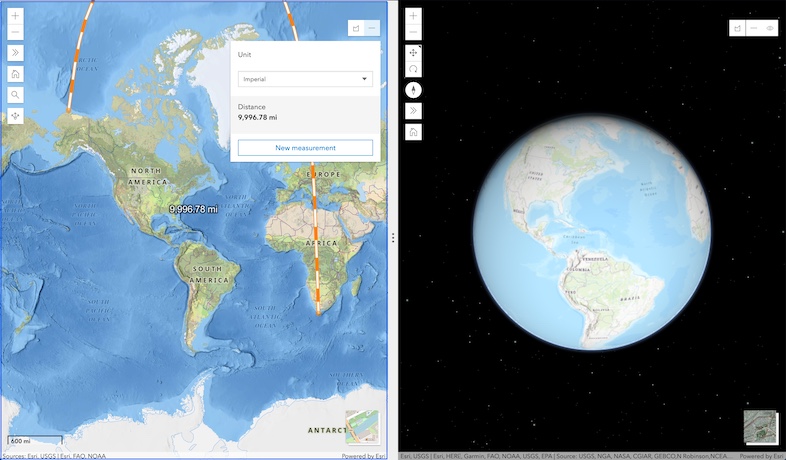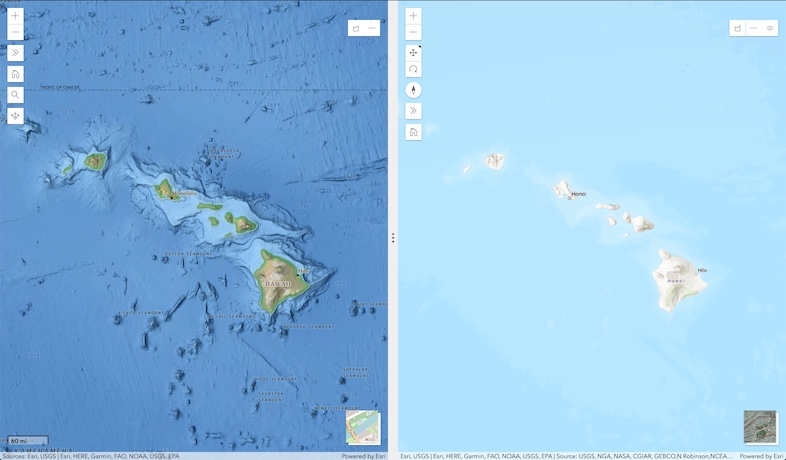- Home
- :
- All Communities
- :
- Industries
- :
- Education
- :
- Education Blog
- :
- Fun with GIS 257: The Power of Simplicity
Fun with GIS 257: The Power of Simplicity
- Subscribe to RSS Feed
- Mark as New
- Mark as Read
- Bookmark
- Subscribe
- Printer Friendly Page
"WHOA! COOL!" is by far the most common phrase uttered when people do one simple step with a simple webapp I created for demos. Adults or students; I've tested as young as age 8. See this "comparison" app, which starts in Hawaii. When the app opens, look in the top left corner of the left map and click the "-" button 3 or 4 times: Open this example app: http://arcg.is/hawaiicompare.
Comparison is a time-tested powertool for learning. Seeing two different presentations of the same location at one time is huge for proving that there is always more than one way to think about any given scenario, and nothing demonstrates at once more powerfully and simply this fundamental capacity of GIS. The left map is a 2D view (Web Mercator projection, standard these days, for better or worse), and the right is a "3D" scene (on a flat screen, starting in "overhead" view). The displays are synchronized, to the degree possible; both can pan, zoom, and rotate, but the right map (being a scene) can also "tilt." Both can swap the basemap with one in the lower right corner, expanding comparisons. This duo uses only basemaps and default tools. It took about ten minutes to set the basics, and another ten to test/tweak/save/repeat. The template can mix or match content types and locations, but coupling a 2D map and a 3D scene generated the desired impact.

- Make a basic map focused on the area of interest, and save it.
- Make a basic scene focused on the area of interest, and save it.
- Open the map, choose to share, choose to make a web app from a configurable template, choose the "Compare" template, and save the web app.
- Configure (this is the time-consuming part), save, and test the web app.
- Share the map, scene, and web app (all three items) alike.

The example above was done using a public account, with no special data or tools. Notice that, using the 2D measure tool, you can see that flying the shortest distance from the northernmost tip of Alaska to the southernmost tip of Africa would involve flying almost due north over the North Pole; you can, of course, confirm it using the line tool in the 3D display. For another situation, I did a similar 2D/3D comparison app using my Organization login, and focused on a single local watershed, showing a downstream trace from a special location and the upstream watershed, so users could tip and rotate and grasp the environment. Careful planning of layers in the map and scene can yield huge impact. Embedding the app in a StoryMap lets the creator provide a little context or instruction (for use in or away from class), and lets the user launch out into full screen.
Many effective activities and lessons are possible with "simple tools." These technologies are not simple under the hood, but their concepts are easy to explain (map, scene, basemap, pan, zoom, rotate, tilt, measure, etc), which lets the user focus on powerful content and instruction. It is much more impressive seeing educators do powerful things with simple tools than simple things with powerful tools. The ArcGIS School Bundle has a great array of tools, all available free to schools and clubs for instruction, around the world. Good teachers master the basics, including the power of simplicity.
You must be a registered user to add a comment. If you've already registered, sign in. Otherwise, register and sign in.
-
Administration
67 -
Announcements
72 -
Career & Tech Ed
1 -
Curriculum-Learning Resources
236 -
Education Facilities
24 -
Events
62 -
GeoInquiries
1 -
Higher Education
570 -
Informal Education
273 -
Licensing Best Practices
76 -
National Geographic MapMaker
29 -
Pedagogy and Education Theory
211 -
Schools (K - 12)
282 -
Schools (K-12)
244 -
Spatial data
30 -
STEM
3 -
Students - Higher Education
242 -
Students - K-12 Schools
119 -
Success Stories
34 -
TeacherDesk
1 -
Tech Tips
101
- « Previous
- Next »
